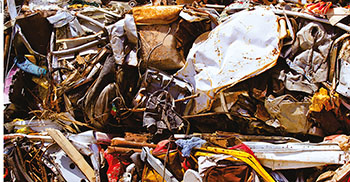GLOBAL GARBAGE DUMP
WASTE IS BEING WASTED!
Yamini Sequeira reports on a conference that sought to sort the global garbage dump

By dumping, burning or land filling, we lose sight of the opportunity to reap the value of both organic and inorganic waste. Held from 13 to 15 September in Perth, the Waste & Recycle Conference 2017 rendered many important lessons on this complex subject.
Themed ‘Sorting Our Waste: Valuing it as a Resource,’ the event focussed on how waste can be converted into a resource in its own right. This theme is of critical importance to present-day Sri Lanka in the aftermath of the mountain of garbage that collapsed onto houses, causing many deaths not long ago.
There could be no greater wake up call for a nation to demonstrate the extent of the problem of waste management than to have its people literally buried under a pile of garbage. Some of the insights shared at the conference could easily be applied to the local context.
The UN reports that a garbage crisis is emerging in the Asia-Pacific region, stoked by escalating quantities of waste on the one hand, and poor regulation and management on the other. Urban populations and economies are expanding; and with increasing numbers of people earning and spending more, consumption and waste are on the rise.
Meanwhile, the World Bank estimates that the generation of daily waste in the Asia-Pacific region will more than double from one million tonnes in 2012 to around 2.5 million tonnes by 2025. Such rates of waste generation will be difficult to manage and in countries where regulation is already weak, this challenge is as serious as it gets.
This is particularly the case in towns and cities in low and middle income countries that tend to lack the know-how, resources and economies of scale to safely handle waste.
But this waste crisis also presents a considerable and largely untapped opportunity. A major portion (tending to range between 50 and 65 percent) of the solid waste generated in low and middle income cities is organic. This waste includes food scraps and garden waste, which can be recycled into compost or transformed into biogas to be used as a source of energy.
In addition, recyclable inorganic materials like paper, plastic and glass make up 26-33 percent of the solid waste in these countries. Overall, around 90 percent of solid waste in these cities can be recycled – and this presents a massive opportunity for waste recovery.
So in effect, waste is being wasted!
By dumping, burning or land filling, the value of both organic and inorganic waste is lost. Recycling these materials enables municipalities, communities and businesses to capture (and retain) this value. But fostering a recycling culture calls for changes in perception that waste – especially organic waste – must be viewed as a resource as well as an opportunity.
The first step in treating waste as a resource is to reuse the waste generated in homes and workplaces. Every time we reuse something, there’s one element less in overcrowded landfills.
One of the key tips shared by recycling experts is to recycle as much as you can and ensure that the waste you can no longer use is in fact used! Consider donating old products to charity shops or trading them in, encourage people to segregate their waste before throwing it out and look into options for composting food waste.
An expert pointed out that recycling reduces the need for virgin resources while using recycled content to manufacture new products conserves energy. Recycling products at the end of their first life cycle maximises and fully realises the benefits of the initial harvest of virgin resources.
Sorting is a key step in recycling and recovering waste. Although recent efforts to sort waste by the Colombo Municipal Council (CMC) have been rather cumbersome, they’re a step in the right direction. Essentially, the more effectively waste is sorted, the more efficient the recycling process is, thereby enabling the production of secondary raw materials of equal or higher quality than the virgin material.
‘Sensor sorting’ is a new trend in sorting waste, which allows near infrared detection of different types of plastic and paper. Some recycling and sorting plants are much like factories in more developed nations with advanced technology such as sensor sorting, which are bringing about greater success in recycling. Other sensor technologies include X-rays, colour detection and the use of 3D laser systems to detect shapes.
“The best opportunities to increase recycling and reduce our trash are by increasing organic recycling and preventing food waste, recycling more paper and cardboard, and increasing the recycling of materials at drop off locations,” notes the recently released 2017 Waste Sort Study conducted by Minnesota’s Hennepin County earlier this year.
Finally, reducing the quantity of waste that residents generate in the first place is the most effective waste management practice. This is something each and every citizen can work towards.
Over the past few years, there’s been much discussion about the problem of garbage disposal but little has been done about it. The time has come to stop talking, and take action to find a sustainable and practical solution to the problem of waste.




